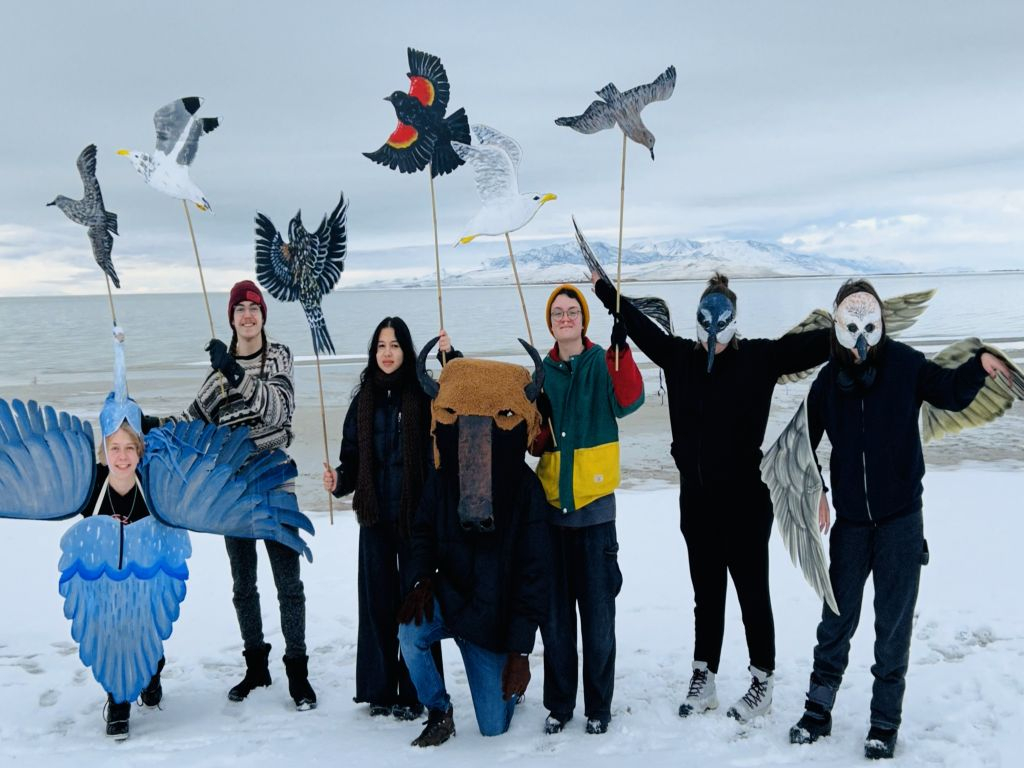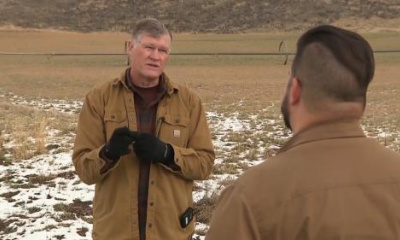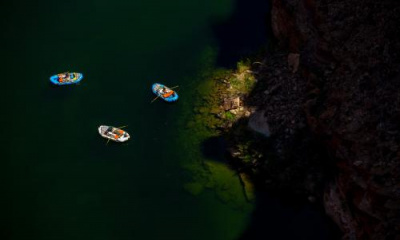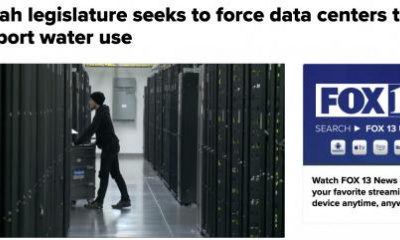They meet with alfalfa farmers, lobby lawmakers and talk easily about the impact of Great Salt Lake on the economy — all while thinking about what they want to do after high school.
They’re members of the Youth Coalition for Great Salt Lake — teenagers from across the Salt Lake Valley focused on education, collaboration and legislation regarding the capitol city’s namesake body of water, said Liam Mountain LaMalfa, the group’s founder.
“Our greatest accomplishment … is bringing to the forefront the notion that the youth care about Great Salt Lake,” said LaMalfa, 18. “The [lake] is directly tied to our future — our future quality of life in the state.”
On April 20, LaMalfa and the group will build on that goal by hosting a “Saline Symposium and Celebration” at Salt Lake Center for Science Education. Open to all ages, the free event will include a youth-led panel discussion, teen speakers and state leaders discussing how to save the lake. Register here.
A three-pronged approach
The coalition launched in the summer of 2023, after the First Unitarian Church’s Environmental Ministry – a group of like-minded adults – started talking to the teens about how they might want to get involved in saving the lake. Lisa Mountain, LaMalfa’s mom, was part of that group.
“I very quickly thought that it would be really important to involve youth, west side residents and youth of color,” she said.
Mountain said the high school group “resoundingly” decided to lobby the legislature. After taking several field trips to the lake and being featured in a July 2023 PBS Utah episode of “Utah Insight,” LaMalfa decided he wanted the group open to all high-school and college-age youth in Utah.
That’s when the group became the Youth Coalition for Great Salt Lake.
The coalition has a three-pronged approach, said Mountain, who acts as an adviser for the group. The teens focus on informing and educating themselves, collaborating with other advocacy groups and lobbying for legislation on Capitol Hill.
She added the group takes initiative, and in less than a year, have toured Bear River Canal Company, participated in vigils at the Capitol and met with lawmakers like Sen. Nate Blouin and leaders like Great Salt Lake Commissioner Brian Steed.
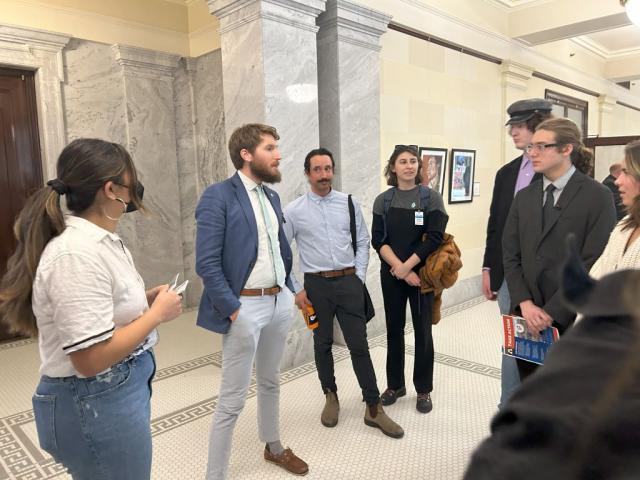
Sen. Nate Blouin talks with members of the youth coalition inside the Utah Capitol Building and during Youth Lobby Day in February 2024. (Photo: Lisa Mountain)
“They inspire me constantly,” Mountain said. “They are motivated and dedicated and passionate about saving Great Salt Lake and about protecting their future in Utah and in the world.”
In early March, at one of their biweekly meetings at First Unitarian Church near the University of Utah’s campus, five of the group’s 15 members shared what the coalition means to them and why they believe saving Great Salt Lake is important.
‘Dirt and crud’
India Elliott, a senior at Granger High School, said she joined the group because she’s always been interested in activism and is concerned about the shrinking lake’s future and its long-term environmental impact. She wants, she said, to be able to grow old in her home state.
“I noticed every winter, and even in the summer, when the air quality gets really bad, and I can barely see the mountains,” she said. “I'm literally looking through dirt and crud … and it makes me feel emotionally worse.”
Great Salt Lake generates around 15 dust events a year, according to reporting by The Salt Lake Tribune. Spring and summer are becoming more unhealthy, and dust from the exposed lakebed could carry arsenic, copper and mercury.
Cloud Garcia-Ruiz, a senior at Salt Lake Center for Science Education, said they’ve always felt a deep connection to the environment, which led them to join the coalition.
“When I heard that the Great Salt Lake was in trouble, I thought, ‘Maybe this is like a chance to finally do something about it,’” Garcia-Ruiz said.
One of their favorite activities was a tree-planting event, they said, because restoring a part of nature that used to be there felt nice. The event last October with the Northwestern Band of the Shoshone Nation allowed the teens to work with the tribe’s mission of stewardship of the land and environment, Mountain said.
For Elliott, attending the vigils for the lake – which took place every morning for all 45 days of this year’s legislative session – stood out as a highlight. Community members interested in saving Great Salt Lake gathered on the steps of Capitol Hill every day. Members from the youth coalition joined every Tuesday at 8 a.m., alongside Nan Seymour, a local poet who has spent the last three legislative sessions holding some sort of vigil for the lake.
“We sing, we dance,” Elliott said. “It's light-hearted when you're kind of, like, surrounded in doom and gloom.”
‘A cultural shift’
Great Salt Lake generates nearly $2 billion for Utah’s economy annually, according to the state’s website. It contributes 5 to 10% to the lake effect snow, creating $1.2 billion for the ski industry.
“We're looking at a serious economic downturn, which is a scary thought to think about the workforce being impacted by losing billions upon billions of dollars in economic growth — gone,” LaMalfa said.
Part of the coalition’s approach is educating others and informing themselves of the science behind Great Salt Lake. Soon after the coalition’s founding, the group toured the Bear River Canal Company, which oversees 126 miles of the Bear River, Great Salt Lake’s largest tributary.
Mountain said they’ve also met with alfalfa farmers and other stakeholders, like Commissioner Steed, to get a variety of perspectives on the issue of the lake. Steed discussed with the group what youth could do to help save the lake, which includes a cultural shift, LaMalfa said.
“To really understand his perspective and cement the notion of cultural change is the thing we need,” he said.
Elliott made a slideshow about saving the lake to educate classmates and friends and to present at events. In it, she argued shifting the culture means changing how people think about using water and made suggestions like removing non-functional turf grass, installing water-wise landscaping and metering water use.
Izzy Khachatryan, a junior at Skyline High School, said she knew she wanted to get other youth involved in the issue of Great Salt Lake.
“Culture drives policy, and we need policy changes in order to get water back to the lake,” Khachatryan said. “In order to do that, we obviously need people to be aware of the issues and be committed to the issues and that starts with advocacy, which is what one of our groups' main focus is.”
Living with the consequences
While Utah lawmakers dubbed 2022 “the year of water,” the most recent legislative session did not deliver the same vigor around issues related to the lake. The number of bills passed was deemed “average” by experts who said lawmakers made enough “technical changes” like measuring, tracking and saving water to keep water policy moving in the right direction.
During the session, members of the youth coalition met with lawmakers – including Blouin, a Democrat representing the South Salt Lake City neighborhood – to discuss how they could be most impactful. Blouin, who has been working with the group since last summer, said engaging with the teens has been great.
“The legislators are not particularly representative of the population as a whole, definitely from an age perspective,” Blouin said. “Giving younger folks an opportunity to get up there and to feel like their voices are being heard even when it can be challenging … that’s important.”
Elliott said it was rewarding to experience lobby day on the hill — asking people to support bills or thanking them for their support.
“It was very empowering to talk to the important people and be heard,” Elliott said.
Utah is a young state, with the latest data from the U.S. Census Bureau showing a median age of 31.3 years with the country’s highest share of people under 18 at 29%.
“These are … young people who are going to have to live with the consequences of the actions that we take as legislators and the decisions we make as a state,” Blouin said.
Students will join other state leaders and lawmakers – including Steed, Rep. Angela Romero and Sen. Luz Escamilla, both Democrats from Salt Lake City – at the event on April 20 as part of a panel discussion about the lake.
As for the future of the coalition, LaMalfa said he would like to bring chapters to high schools and the University of Utah. The group, he said, has made it clear Great Salt Lake is their future.
“The more I talk to people, the more people seem to have a little bit of an understanding of Great Salt Lake,” he said. “That understanding seems to be getting steadily larger … [and] when every person in the state really knows about Great Salt Lake, it'll be impossible to do anything but save her.”

